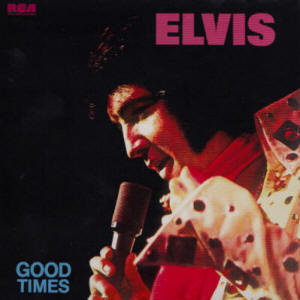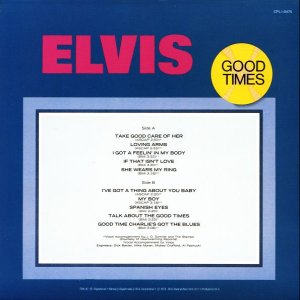Verdict
Vocally Elvis is very strong and he delivers a great mix of kitsch, country, ballads and some up-tempo songs.
![]()
(C) RCA Records
The ultimate site about the king of the analogue age


The compilation "A Legendary Performer - Volume 1" was followed in March 1974 by "Good Times", an album with new recordings. Billboard listed it on the "Top LPs Chart" for eight weeks, beginning on April 6th. But the long player didn't get far and never made it past number 90. On April 27th "Good Times" also entered the "Hot Country LPs Chart". Here the 200,000 sold units were enough for a run of 14 weeks and a solid number 5. Worldwide the album was retailed a million times, which translates to 150 million paid streams of the complete record or 1.5 billion individual tracks. These figures proved once again that Elvis had turned into a catalogue artist. Compilations of well known songs or live recordings still sold well, but just a few people were interested in the king's current work.
In 2016 the complete Presley catalogue was restored and remastered by Vic Anesini for a boxed set of 60 compact discs called "The Album Collection". Sony Music Entertainment provides the streaming platforms with the same versions of the individual albums (some of them offering bonus tracks), albeit in 24 bit/90 khz flac. That means, if the platform of your choice supports high resolution audio, you can enjoy the tracks in the same quality Sony used to scan and master them. On Spotify, which has a market share of approximately 30% and is the only platform that publishes streaming figures, "Good Times" accumulates 45 million streams. So one might say it gained some popularity over the decades.
In a German magazine I once read that Elvis looks on the cover like an aging, chubby drag queen in a glitter dress. I had to laugh out loud, because somehow the reviewer hit the nail on the head. The photo doesn't do the king any favors. It was made in June 1972 and was retouched, because Elvis lifts his middle finger a bit and Colonel Parker feared that someone might think the king was giving the finger. It's almost unusual that RCA Records didn't use the backside of the sleeve as advertising space for other Presley records.
The album has a running time of 29:23 minutes.
The songs were recorded at the Stax Studios in Memphis/Tennessee between December 10th and 16th 1973. The sessions were produced by Felton Jarvis and engineered by Mike Moran and Dick Baxter. Elvis' band consisted of James Burton (guitar), Johnny Christopher (guitar), Charlie Hodge (guitar), Norbert Putnam (bass), Ronnie Tutt (drums), David Briggs (piano and organ) and Per-Erik Hallin (piano, clavinet and Wurlitzer Piano). The backup vocals were provided by J.D. Sumner & The Stamps (J.D. Sumner, Ed Enoch, Bill Baize and Dave Rowland), Voice (Donnie Sumner, Sherrill Nielsen, Tim Baty and Per-Erik Hallin) as well as Mary Holladay, Kathy Westmoreland, Susan Pilkington and Jeannie Green. In total the group recorded 18 masters which were used on the albums "Good Times" (1974) and "Promised Land" (1975).
In 2009 Follow That Dream Records released a collector's edition of "Good Times". To read the review tap HERE.
Take Good Care Of Her
Elvis recorded this ballad on July 21, 1973 at the Stax Studios in Memphis/Tennessee within six takes. On September 28th Felton Jarvis added strings and a guitar. The song by Ed Warren and Arthur Kent was recorded for the first time by Adam Wade, who scored a top 10 hit with it in 1961. Elvis' version was supposed to be released on "Raised On Rock / For Ol' Times Sake", but he insisted on holding the track back for a separate release on a single. And so it premiered in early 1974 on the b-side of "I've Got A Thing About You Baby" and was later re-released on "Good Times". The narrator begs the new partner of his loved one to take care of her. The lyrics are quite pathetic and the production pulls out all the stops regarding kitsch and schmaltz. Even though everything is over the top, I love this song. Elvis is in very good voice and he sells the song in an emotional and absolutely believable way. No wonder many fans still think that the king pulls out his heart and sings directly to Mike Stone, who was Priscilla's partner at the time.
Loving ArmsOnce again the singer longs for the return of his lady, but this time it was him, who broke up. Compared to "Take Good Care Of Her" the lyrics are far less bold and simple and musically no sloppy sentimentality can be found. Elvis is in strong voice and performs "Loving Arms" extremely well. The king followed the interpretation of Dobie Gray, whose version had been recorded just a few months earlier. He obviously new the song well, because on December 13, 1973 he just needed three takes to deliver a perfect performance. On January 10, 1974 Felton Jarvis silenced the harmony singers and added strings.
I Got A Feeling In My BodyThe two ballads are followed by a religious funk written by Dennis Linde, who had also delivered "Burning Love" in 1972. The lyrics can be summerized with "With God everything is fine". Musically the song is very different to what Elvis usually recorded at the time. It's funky and modern (at the perspective of 1974) and the king obviously is enjoying himself singing it. On December 10, 1973 Elvis recorded seven takes of "I Got A Feeling In My Body", the third attempt was enhanced with harmony voices and further instruments.
If That Isn't LoveAnother religious song, this time a ballad. Elvis is singing about Jesus' love for humans and does it in an extremely schmaltzy way. Of course there are also truckloads of choirs and strings. I have to admit that I like this Christian kitsch very much, because the melody is nice, Presley is in great voice and he sings with a lot of emotion. "If That Isn't Love" was written by Dottie Rambo, a member of the gospel group The Singing Rambos (no irony here, because the movie franchise started over a decade later). The group recorded the song in 1969. On December 16, 1973 the king put seven attempts on tape and selected the fourth take for release. Before this was done, Felton Jarvis added violins on January 11, 1974.
She Wears My RingWay back in 1960 Elvis had taped a performance of "She Wears My Ring" at home, but it took him until December 16, 1973 before he recorded the song professionally. Even though he knew the ballad well, he needed ten takes to reach a satisfactory result. The production was finished on January 11, 1974 by overdubbing strings. Even though the singer enthuses about the love for his wife Elvis' voice carries a touch of melancholy. It doesn't fit the lyrics at all, but strangely though it doesn't feel out of place. It's a very good performance. "She Wears My Ring" is based on "La Golondrina", written by Narciso Serradel Sevilla in 1862. The English lyrics were provided by Boudeleaux and Felice Bryant.
I've Got A Thing About You BabyHere we have another declaration of love, albeit brisker and without any kitsch. This is no surprise, because the song was written by Tony Joe White, who also was the first to record it. Elvis did so on July 22, 1973 and needed 15 takes. Overdubbs were made on September 28th. RCA and Colonel Parker wanted to release it on "Raised On Rock / For Ol' Times Sake", but Elvis kept the track back for a separate release on a single. This was done in early 1974.
My BoyThe ballad "Parce Que Je T'Aime, Mon Enfant" was written by Claude Francois and Jean Pierre Bourtayre, Bill Martin and Phil Coulter later provided English lyrics. In 1971 the actor Richard Harris scored a top50-hit with "My Boy". The king performed the song during his "Elvis Summer Festival 1973" in Las Vegas and recorded it in the studio on December 13, 1973 within three takes. Felton Jarvis edited the master take and overdubbed it with strings (January 10, 1974) and horns (January 15, 1974). In November 1974 "My Boy" was released in Great Britain and peaked at number 5 of the charts. The success triggered a US release in early 1975, but on the Billboard Charts the single stagnated at number 20. The song is a monologue of a father in front of his sleeping son. He confesses that the love for his wife had died a long time ago, but it would break his heart to leave and not be able to see him growing up. Elvis' voice is so full of loneliness and sadness that one just has to believe every word he sings. Without doubt "My Boy" is one of the king's best performances ever.
Spanish EyesOriginally this song was an instrumental by Bert Kaempfert, before Charles Singleton and Eddie Snyder added English lyrics. The Austrian singer Freddy Quinn (Franz Eugen Helmuth Manfred Nidl) was the first to record "Spanish Eyes", but it was Al Martino, who scored a hit with the song. The narrator says goodbye to his loved one, a blue-eyed Spanish lady. In real life this is a true rarity, but I guess Singleton and Snyder needed an additional word because otherwise they would have had to stretch "spanish" too much in the melody. The song is a classic and Elvis obviously liked it. He sang it a lot in private and also included it in his stage show in early 1974. The studio version was recorded on December 16, 1973, take 4 became the groundwork of the master. The production was finalized on January 10, 1974 with the addition of violins.
Talk About The Good TimesThe singer is thinking about the old days, in which -of course- everything was much better. He does so in form of a country rock, which sounds mighty fine and is performed with obvious joy. "Talk About The Good Times" was written by Jerry Reed, who scored a top20 hit on the country charts with the song in 1970. Elvis recorded the tune on December 14, 1973 within 4 takes. On January 2, 1974 Felton Jarvis added harmony vocals and shortened the performance of half a minute.
Good Time Charlie's Got The BluesDanny O' Keefe wrote and recorded the song in 1969. Elvis taped his version on December 13, 1973, the ninth attempt was selected for post-production and release. On January 2nd and 15th 1974 further instruments were added and the recording was shortened of 1.5 minutes. The singer feels lonely, because everybody is leaving the town. He is on the decline and even has to take pills to bear the situation. Elvis left out the part with the pills, I guess it was a tad too close to his own life. Nevertheless it's an excellent performance, certainly one of his best from the 1970s.
Vocally Elvis is very strong and he delivers a great mix of kitsch, country, ballads and some up-tempo songs.
![]()
(C) RCA Records